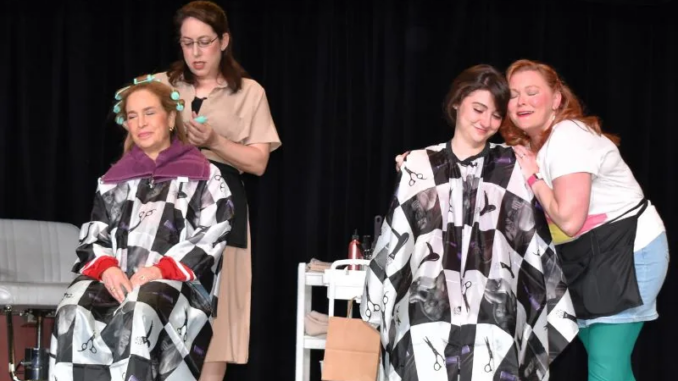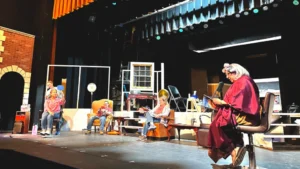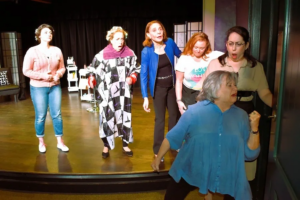
A strong ensemble carries ‘Steel Magnolias’ at Gaithersburg Arts Barn
The first act is delightful, engaging, and laugh-out-loud funny; the second act, not so much.Vanessa Markowitz, director of The Montgomery Playhouse’s production of Steel Magnolias at the Gaithersburg Arts Barn, begins her program note by confessing: “I used to hate this play.”
There’s no denying Steel Magnolias’ significance in theatrical history. With a script written by Robert Harling in just ten days, the original 1987 production spawned runs on Broadway and the West End, two movie adaptations, a national tour, and countless performances at community theaters across the country. Many leading ladies have launched their careers or hit their stride by playing one of the characters in this story.
But I’ve always struggled with the format of the play, and have never seen a production that moved me to understand its staying power. I was heartened by Markowitz’s note; if she could learn to love Steel Magnolias, perhaps her production could teach me, too.
If the production had stopped at intermission, it would have succeeded. Delightful, engaging, and laugh-out-loud funny, Act I filled me with optimism. But Act II, though punctuated by individual moments of good acting, progressed with its usual dramatic stumbling blocks and left me wondering how any director can keep this play interesting to its final moments.In case you’ve never seen it, Steel Magnolias takes place inside a beauty salon set in Chinquapin, Louisiana, in the 1980s. The play opens with the vivacious salon owner, Truvy, hiring a new girl in town, Annelle. We soon meet Clairee, the recently widowed former mayor’s wife; Shelby, the youngest member and heart of the group; her brass-tacks but caring mother, M’Lynn; and the ornery but lovable older Ouiser. Shelby’s life events feed the main reason for gathering and gossiping, from her wedding to her complications with Type 1 diabetes. Along the way, we discover the other characters’ search for meaning, and how they support each other through it all.

The first act owed much of its success to the strength of the ensemble, who took command of their roles and played their characters with sincerity.
As Truvy, an upbeat Rachel Brightbill moved through her salon with open charisma, making it easy for me to see how someone as shy as Annelle (a highly entertaining Sara Joy Lebowitz) or as wild as Ouiser (a spunky Hillary Mazer) would feel equally at home in her space. Clairee (played by Carole Preston) brought innate poise and positivity to her situation, while a wilder Ouiser contrasted her in almost every regard.
As mother and daughter duo, Shelby (Emily Ray) and her mother M’Lynn (Jill Goodrich) had wonderful chemistry, delivering rapid-fire text with composure and pluck. Their spats and their moments of love were played with a believable light touch, and their frequent check-ins with one another created an undercurrent of connectivity that ran deeper than the bonds between the other women.
Markowitz also directed some good moments of physical comedy in the first act, particularly with the character of Annelle. Played with energetic range by Sara Joy Lebowitz, Annelle was best at staying available to all the goings-on of the salon; you could always count on her for an opinion or reaction. She also had the clearest physical relationship to the space, developing her movement as her character settled in from timid scurrying and double-checking directions to spinning in a salon chair with comfortable ease.

The costumes, well chosen and appropriately curated to reflect the 1980s by Talon Bevan, hit a perfect balance of wackiness and believability, and I enjoyed taking in the new outfits with each scene change.
I entered intermission captivated by this community of friends within the salon, and intrigued by the clear images they painted of the goings-on of the world beyond its doors.
But the second half of this play does not bring enough dramatic action to sustain the elements that made Act I so compelling. We are still in the salon. The characters, though changing slightly, are only marginally progressing on the paths we watched them find at the end of the first act. Most of the action still occurs offstage, and we watch characters respond to second-hand news in almost exactly the ways we’d come to expect from them. The major event of the play has been hinted at before intermission, and becomes increasingly telegraphed to the point of losing its dramatic impact when it finally happens (again, offstage).
The set, efficiently designed by Cassandra Redding to include a hair-washing station, resting couch, two main styling chairs, and a manicure station, was underutilized in the second half of the production. Rather than taking advantage of seating, levels, and depth, the actors often found themselves a bit stuck in straight-line blocking near the front of the stage, rendering them less active. Line pickups and reaction times were also
